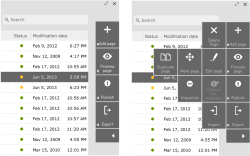Touch-aware Magnolia 5.0 released
 Version 5.0 of the open source Magnolia CMS has been released after a year and a half spent redeveloping the front end tools that deliver content to the CMS's users. Talking with The H, Pascal Mangold, CEO of Magnolia, explained that Magnolia 4.5 had seen the redevelopment of the backend of Magnolia to create a foundation for the work that has been delivered in Magnolia 5.0. Magnolia is a Java CMS that is built around the concept of being an enterprise integration platform, connecting users with enterprise systems in an accessible way.
Version 5.0 of the open source Magnolia CMS has been released after a year and a half spent redeveloping the front end tools that deliver content to the CMS's users. Talking with The H, Pascal Mangold, CEO of Magnolia, explained that Magnolia 4.5 had seen the redevelopment of the backend of Magnolia to create a foundation for the work that has been delivered in Magnolia 5.0. Magnolia is a Java CMS that is built around the concept of being an enterprise integration platform, connecting users with enterprise systems in an accessible way.

![]() Editing on the iPad with the new Magnolia touch interface.
Based around the Vaadin toolkit, the new user interface is designed to offer HTML5 responsive scaling to desktop PC, tablet and phone devices without placing extra load on the developer creating the tasks. As part of the design, users now have task-oriented "Apps" and "Content Apps" to work with custom data-types, "Pulse" to give them real-time updates on actions and content changes, and "Favorites" to give them quick user-definable access to the Magnolia functionality.
Editing on the iPad with the new Magnolia touch interface.
Based around the Vaadin toolkit, the new user interface is designed to offer HTML5 responsive scaling to desktop PC, tablet and phone devices without placing extra load on the developer creating the tasks. As part of the design, users now have task-oriented "Apps" and "Content Apps" to work with custom data-types, "Pulse" to give them real-time updates on actions and content changes, and "Favorites" to give them quick user-definable access to the Magnolia functionality.
The design of the new interfaces has been driven, says Mangold, by a desire to get rid of the drop-down-menu-centric approach which has pervaded many front-end toolkits and move to something that is more in line with the consumer-centric approaches of smartphone and tablet applications with simple navigation,

![]() Magnolia's touchable options use collapsing and expanding elements on the "Action Bar".
Magnolia's touchable options use collapsing and expanding elements on the "Action Bar".
explicit visible options and easy to hit buttons.
The backend of Magnolia is architecturally unchanged from Magnolia 4.5, with connections to a number of enterprise platforms and integration routes with the Spring Framework, Groovy and Ruby. The content management system can interoperate with JCR-compliant document stores and CMIS-compliant repositories and there is built-in support for a number of third-party web services.
Magnolia 5 is, though, not the end of the development story; Mangold noted that that it was more the completion of a rewrite that was preparing Magnolia for its next generation of feature development. He sees 5.0 as a

![]() Magnolia's "App" screen looks almost identical on desktop and touch devices.
point where Magnolia is part of a process of opening up the platform and is better packaged for users to access its capabilities. For example, later this year, an app discovery platform is due to be integrated to allow for the sharing of Magnolia Apps. More integration work will be developed with partners and then open sourced, which should allow other developers to step in and adopt the best practices demonstrated in the released code. Virtual previews of content and apps is also on the roadmap.
Magnolia's "App" screen looks almost identical on desktop and touch devices.
point where Magnolia is part of a process of opening up the platform and is better packaged for users to access its capabilities. For example, later this year, an app discovery platform is due to be integrated to allow for the sharing of Magnolia Apps. More integration work will be developed with partners and then open sourced, which should allow other developers to step in and adopt the best practices demonstrated in the released code. Virtual previews of content and apps is also on the roadmap.
Magnolia 5 is available as commercial Enterprise standard and pro editions, which include extra features over the GPLv3-licensed Community Edition. The Community Edition is available to download from SourceForge.
(djwm)
![Kernel Log: Coming in 3.10 (Part 3) [--] Infrastructure](/imgs/43/1/0/4/2/6/7/2/comingin310_4_kicker-4977194bfb0de0d7.png)

![Kernel Log: Coming in 3.10 (Part 3) [--] Infrastructure](/imgs/43/1/0/4/2/3/2/3/comingin310_3_kicker-151cd7b9e9660f05.png)
















